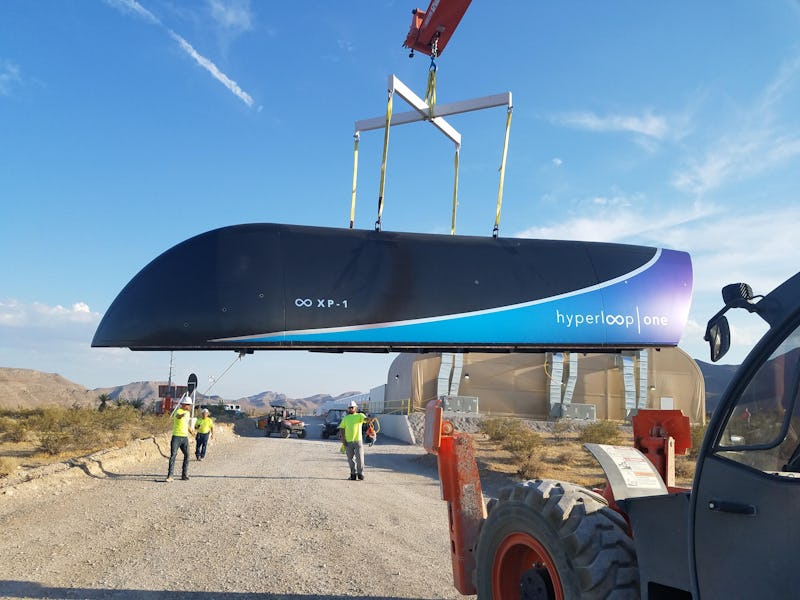On Wednesday, Hyperloop One, the Los Angeles-based transportation startup looking to make Elon Musk’s famed 2013 white paper about vacuum-tube transportation a reality, announced it has done it: A “successful completion of the world’s first full systems Hyperloop test in a vacuum environment,” the company declared with a press release.
The private test was held on May 12 at the company’s “DevLoop” test tube in the desert north of Las Vegas, and the test pod — propelled by electricity and lifted by magnetic levitation inside the tube — “coasted” for 5.3 seconds, topping out at 70 miles per hour. Phase 2 of testing includes hitting a top speed of 250 mph. Musk’s white paper predicted the transportation pods could hit 700 mph.
“Hyperloop One has accomplished what no one has done before by successfully testing the first full scale Hyperloop system,” said Shervin Pishevar, co-founder and executive chairman of Hyperloop One, in a statement.
He’s right. While there are other Hyperloop projects — including Arrivo, a startup led by a former Hyperloop One engineer — none have done a full-scale test. SpaceX has hosted student competitions with successful results, but the tube was about half the size, as were the pods.
“By achieving full vacuum, we essentially invented our own sky in a tube, as if you’re flying at 200,000 feet in the air,” Pishevar continued. “For the first time in over 100 years, a new mode of transportation has been introduced. Hyperloop is real, and it’s here now.”
Achieving full vacuum had been a challenge for Hyperloop One, Josh Giegel, co-founder and president of engineering of Hyperloop One, told Inverse earlier this year. Giegel compared the electricity arcing inside the tube to this scene in The Matrix.
“We thought that there would be a lot more commercial connectors that are able to deal with the vacuum environment for us connecting our motor,” Giegel told Inverse in January. “It turned out we had to do a lot of developing on our own to go after that ourselves. Essentially, the plug that would work in your wall in your house doesn’t work in a vacuum particularly well.”
The prototype of the Hyperloop One pod, first revealed publicly on July 12.
What’s next? Hyperloop will keep testing to validate hardware and software. A representative for Hyperloop One tells Inverse that a public test will happen in “the coming months.”
Here’s an abbreviated timeline of Hyperloop One’s milestones:
September 9, 2013: France’s state-owned railway company SNCF backs Hyperloop One.
February 12, 2015: Hyperloop One raises $11.1 million in Series A funding.
September 16, 2015: Then known as Hyperloop Technologies, the company raises $80 million and announces Rob Lloyd as CEO.
December 8, 2015: Hyperloop Technologies announces a land deal for an open-air test in Las Vegas. The test is expected for early 2016, and they expect a functioning system by 2020.
May 10, 2016: Hyperloop Technologies announced it has $80 million in Series B funding.
May 11, 2016: Hyperloop Technologies tests its propulsion system on a test track in Nevada. It predicts a full-scale public test by the end of the year.
May 14, 2016: Hyperloop Technologies changes its name to Hyperloop One. There had been confusion in the market with another company called Hyperloop Transportation Technologies.
June 21, 2016: Hyperloop One partners with the Russian Summa Group to develop a transportation system that will span 4,800 miles across Russia.
July 27, 2016: Hyperloop One has a new manufacturing plant in Nevada and begins producing parts for a prototype.
August 15, 2016: Hyperloop One announces plans to construct a high-speed shipping system in Dubai.
March 7, 2017: Hyperloop One reveals a shortened DevLoop in the Nevada desert. It was originally slated to be 3,000 meters but is 500.
April 6, 2017: Hyperloop One reveals 11 possible routes for the United States.
April 19, 2017: Hyperloop One defends delays with its technology.
TBA: A full-scale public test.
Additional research by Dan Robitzski.
